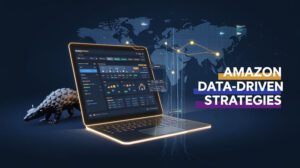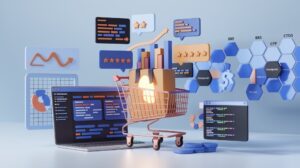Introduction: Nvidia Leads the New AI Epoch
In today’s fast-paced technological landscape, artificial intelligence (AI) has become a key driver of societal progress. Nvidia, a global leader in AI technology, showcased significant breakthroughs during CEO Jensen Huang’s landmark speech at Computex 2024. This event not only highlighted Nvidia’s latest advancements in AI but also heralded the arrival of the robotics era.
The Dawn of the Robotics Era: Nvidia’s AI Revolution
Speaker: Jensen Huang, Nvidia CEO and Co-Founder
Venue: Computex 2024, Taipei International Computer Show
Key Points of the Speech:
- Huang unveiled the mass-produced Blackwell chip and announced the 2025 release of the Blackwell Ultra AI chip. The next-gen AI platform, named Rubin, will launch in 2027, with annual updates aimed at surpassing Moore’s Law.
- Nvidia’s post-2012 GPU architecture overhaul integrated new technologies into a single computer, enabling the development of large language models.
- Nvidia’s accelerated computing technology achieved a 100-fold speed increase, with power consumption tripling and costs rising by 1.5 times.
- Huang predicted that next-gen AI must understand the physical world, suggesting methods of learning through video and synthetic data and promoting mutual learning among AIs.
- Huang introduced the Chinese term “词元” (cí yuán) for “token” during his presentation.
- The robotics era is imminent, with all mobile entities expected to achieve autonomy in the future.
Full Speech Highlights:
- Huang thanked National Taiwan University for hosting and shared experiences of innovation with Taiwanese partners.
- He discussed how AI propels a global industrial revolution and the impact of generative AI across various sectors.
- Nvidia’s prominence at the intersection of computer graphics, simulation, and AI, along with the significance of the Omniverse virtual world, was emphasized.
- Huang addressed the rising power consumption and computational costs of global data centers and the benefits of accelerated computing technology.
- He predicted acceleration for all computation-intensive applications and complete acceleration for data centers.
- He outlined how 350 function libraries facilitate new market expansion and the virtuous cycle enabled by CUDA technology.
- Huang highlighted AI’s rise and the feasibility of training large language models due to significantly reduced computational costs.
- The “Earth 2.0” project, aimed at creating a digital twin of Earth to predict future changes, was discussed.
- The emergence of AI supercomputing and Nvidia’s role in supporting deep learning through technical innovations was explored.
- Huang described how generative AI reshapes the software stack, showcasing NIM cloud-native microservices.
- He forecasted PCs becoming the primary carriers for digital humans and Nvidia’s advancements in digital human technology.
- The full production of Blackwell GPUs and the 1000-fold increase in computing power over eight years were highlighted.
- Huang announced the Blackwell Ultra and the upcoming Rubin platform, underscoring Nvidia’s ongoing technological pursuits.
AI and the Physical World Integration
Huang further emphasized the importance of next-generation AI understanding the physical world. His proposed methods of learning through video and synthetic data will enable AI to better simulate and predict real-world complexities. This indicates that future AI will be more intelligent, seamlessly integrating with human society to achieve more efficient human-machine collaboration.
The Importance of Data Scraping: A Key to Training Intelligent Robots
As robotics technology rapidly advances, the volume of data required to train these intelligent robots is also increasing dramatically. Efficiently capturing and aggregating this training data has become a crucial issue in the AI field. The quality, accuracy, and processing speed of data directly impact the learning efficiency and ultimate performance of intelligent robots.
Pangolin Scrape API: A Powerful Tool for Data Scraping
In this data-driven era, the Pangolin Scrape API has emerged, specifically designed for data collection. It helps enterprises and researchers efficiently gather, organize, and analyze data, providing robust support for training intelligent robots.
Features of Pangolin Scrape API
The Pangolin Scrape API boasts numerous features, including but not limited to:
- Efficiency: Rapidly capture web data, enhancing data collection efficiency.
- Accuracy: Precisely identify target data, reducing errors and omissions.
- Ease of Use: User-friendly interface design, simplifying the operation process.
- Customizability: Tailor data collection schemes according to customer needs.
Functions of Pangolin Scrape API
The Pangolin Scrape API offers a range of functions to meet data collection needs in various scenarios:
- Automated Collection: Automatically scrape web data without manual intervention.
- Data Cleaning: Automatically remove invalid or redundant data, ensuring data quality.
- Intelligent Recognition: Use AI technology to identify and extract key information.
- API Integration: Easily integrate with other systems or platforms to enable data sharing.
Advantages of Pangolin Scrape API
Among numerous data collection tools, the Pangolin Scrape API stands out with its unique advantages:
- Cost-Effectiveness: Significantly reduces time and economic costs compared to manual collection.
- Data Security: Ensures data security and privacy protection during the collection process.
- Technical Support: Provides professional technical support to solve user problems during use.
- Continuous Updates: Continuously updates and optimizes the product to adapt to the ever-changing market needs.
Embracing the Robotics Era and Creating an Intelligent Future
Huang’s speech not only showcased Nvidia’s ambition in the AI field but also painted a picture of a future where robotics technology is becoming increasingly sophisticated. With the development of data collection tools like the Pangolin Scrape API, we have every reason to believe that training intelligent robots will become more efficient and precise.
Intelligent robots will shine in various fields, from manufacturing to services, healthcare to home life, significantly improving productivity and quality of life. This achievement relies on the support of data collection tools like the Pangolin Scrape API, which provide rich data resources for training intelligent robots and accelerate AI technology development.
Conclusion: Moving Forward Together and Opening a New Chapter in AI
As technology continues to advance, we are standing at the threshold of a new era. Nvidia’s Blackwell platform and innovative tools like the Pangolin Scrape API will open a new chapter full of infinite possibilities in AI. Let us embrace the robotics era together, explore the depth and breadth of AI technology, and create a smarter, more efficient future.






